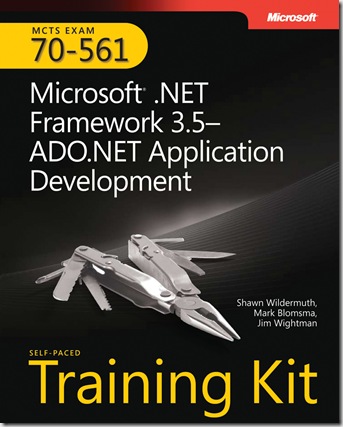New book: MCTS Self-Paced Training Kit (Exam 70-561): Microsoft .NET Framework 3.5—ADO.NET Application Development
If you’re studying for Microsoft exam 70-561 or just looking for a self-paced guide to ADO.NET, it’s worth checking out the new 70-561 Training Kit. The 70-561 exam is one of 2 required exams, along with 70-536, for earning your MCTS: .NET Framework 3.5, ADO.NET Applications certification. This exam is also one of the requirements for the prestigious MCPD: Enterprise Application Developer 3.5 certification.
To give you a sample, we’ve included an excerpt from the Introduction and, by popular request, one of the several Real World sidebars in the book:
Introduction
This training kit is designed for developers who plan to take Microsoft Certified Technical
Specialist (MCTS) exam 70-561, as well as for developers who need to know how to create
data-driven applications using the ADO.NET and Microsoft .NET Framework 3.5. We assume
that before you begin using this kit, you have a working knowledge of the .NET Framework,
databases, and Microsoft Visual Basic or C#.
By using this training kit, you learn how to do the following:
■ Connect to a variety of data sources
■ Query data
■ Use Language Integrated Query (LINQ)
■ Change data and use transactions
■ Work with the Entity Framework and LINQ to SQL for object-relational mapping
■ Synchronize data across disparate devices and tiers
■ Work with ADO.NET Data Services for Internet applications
REAL WORLD
James Wightman
To fully appreciate the power and performance of ADO.NET 3.5, one must recall
its more humble beginnings—from Data Access Objects (DAOs), Remote Data
Objects (RDOs), ActiveX Data Objects (ADOs), and the earlier versions of ADO.NET
that shipped with previous editions of the .NET Framework. Since 1996, Microsoft
has been building on their Data Access technology—previously known as Microsoft
Data Access Components (MDAC)—rapidly evolving capability and performance
with each release.
Setting up the database connection has always been the first step when developing
a Microsoft Windows–based software solution. Generally speaking, the majority
of the decisions about how to connect to a data source revolve around the
target database technology and the type of security being used. From project to
project, many of the configurable options stay the same—for example, the use
of connection pooling, the type of data provider, timeout thresholds, and other
connection properties.
The reality is that while you are typically using identical code in each project to
connect to your desired data source—except for modifying the connection string
slightly, that is—it is incredibly useful to appreciate the nuances and subtleties of
the Connection object for those times where a project veers from the well-trodden
path. Many developers I know have created a set of classes—helpers, if you will—that
contain the code necessary to connect to a data source and can be reused in different
projects. I personally take the time to review my database helper classes regularly
so I can use the latest and most appropriate features of ADO.NET. Aside from these
occasional updates, I can reuse my database helper classes each time I need to
consume a data source, which means I can concentrate on implementing business
rules instead of worrying about how I’m consuming the data.
